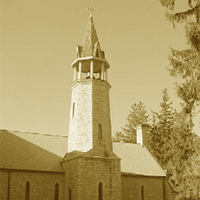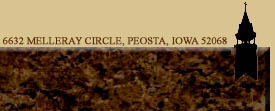 On July 16 A.D. 1849, shortly after the acquisition of 1,000 acres of rolling prairie and woodland southwest of Dubuque, and one cow and calf from one Cornelius Duggan for $14.00, the venerable Dom Bruno Fitzpatrick, Lord Abbot of Mount Melleray, Ireland, pontificated at the cornerstone laying ceremony. He pointed with his cane where the location was to be, and three brawny Irish brothers (Ambrose, Joseph and Timothy) slapped down a big chunk of oak. Thus the building project that was to become New Melleray got underway.
On July 16 A.D. 1849, shortly after the acquisition of 1,000 acres of rolling prairie and woodland southwest of Dubuque, and one cow and calf from one Cornelius Duggan for $14.00, the venerable Dom Bruno Fitzpatrick, Lord Abbot of Mount Melleray, Ireland, pontificated at the cornerstone laying ceremony. He pointed with his cane where the location was to be, and three brawny Irish brothers (Ambrose, Joseph and Timothy) slapped down a big chunk of oak. Thus the building project that was to become New Melleray got underway.
Mount Melleray is located in County Waterford, Ireland. In the nineteenth century, it like most of Ireland was faced with the famine that destroyed almost a third of the population of the country. Faced with starvation and the diminishing ability to support the poor and starving in their area of the country, the monks were forced to begin to look elsewhere for a home. Like so many other Irishmen of the time, their gaze turned towards America.
Upon completion of the original temporary wooden monastery building by the founding group of six monks, 16 additional monks were sent from Ireland to pave the way for the next phase of the building project. Unfortunately, six of the latter group, including the most skilled artisans, died of cholera on the steamboat coming up the Mississippi from New Orleans. Undaunted, the intrepid Iish sent 13 more, one of whom, Brother Francis, an architect, died on the Atlantic crossing and was buried at sea. (Besides the loss of so many members, the first winter in Iowa was an extreme hardship on the little community.)
The First Winter in Iowa
(The following is taken literally from Brother Kiernan Mullaney's handwritten history of the founding of New Melleray in 1849. Brother Kiernan died at the age of 77, June 16, 1894. His grave is in the New Cemetery, No. 10, Row D.)
On our arrival in Dubuque, Brother Ambrose led us to the City Hotel where Mr. Dennis Mahoney and General Warner Lewis came to welcome us to Iowa. Next day we proceeded to our new home, which when contrasted with the home we left in Ireland was a sad affair. The country, at least for some miles out from town, has a desolate appearance, hilly, rugged and bare, snow-covered and chilly, with but very few people, as its wild uncultivated appearance indicated.
Brother Ambrose hired a conveyance in town into which Father Patrick and the rest of us crammed ourselves, while the hired man (Jerry Healey) with his two yoke of cattle hauled part of our baggage but forgot the essential part--namely, our bed-clothes, so we slept that night in a heap of straw in the New Shed, the sheeting sufficed to keep out the snow but let in the frozen breeze, this was our first night's lodging in New Melleray.
Had we time to burrow into the earth and like many of our neighbors live in "dug-outs" we would be much more comfortable our first winter in Iowa. No, the frost set in so severe on the 4th of December as to prevent any more burrows being made that winter.
Our livestock then was very limited, a pair of horses and one old cow, the same cow was made a present to the Brothers by the Sisters of St. Joseph's convent residing three miles east of here. It is difficult indeed to tell all the acts of kindness them good Sisters with their Father and founder, the Very Rev. Terrence Joseph O'Donahue done for our little community, for instance the baking of bread for us during the years 1859 and 1850, yes, and part of 1851.
During three years the good Sisters made and mended our stockings, and it can never be forgotten what they done at the time we had but four horses. Brother Barnaby drove a pair of them to the convent to bring home a batch of bread, that was in July, 1851. They were not more than twenty minutes in the shed when lightning hit it, killing the horses in an instant. Three of the Sisters had a narrow escape, they were milking cows in the shed, and had gone out of it only a few minutes when it was knocked down by the lightning.
But our loss was very soon made all right by Father O'Donahue sending over the price of a pair of horses. And what did the good Sisters ask of us for their many generous deeds? Simply our prayers, and a priest once in a while to fill in for their aged Pastor.
Truly as long as New Melleray exists, them kind-hearted Sisters should be remembered.
![[PHOTO]](menuimages/smold01.jpg) Gradually additional land was acquired, needed improvements made on the grounds, and auxiliary buildings erected. Finally, at the close of the Civil War, remote preparations began for a permanent stone monastery. Stones were cut and hauled from the quarry, lumber stock-piled, and hard-earned cash set aside for future construction costs. So in March 1868, some 20 years and 500 catastrophes after the founding, construction of the first two permanent wings got underway.
Gradually additional land was acquired, needed improvements made on the grounds, and auxiliary buildings erected. Finally, at the close of the Civil War, remote preparations began for a permanent stone monastery. Stones were cut and hauled from the quarry, lumber stock-piled, and hard-earned cash set aside for future construction costs. So in March 1868, some 20 years and 500 catastrophes after the founding, construction of the first two permanent wings got underway.
The plans for the Abbey were drawn up by a Dubuque architect by the name of John Mullany. For three years John Mullany had been in England on the staff of none other than Augustus Welby Pugin, an architectural genius of the 19th century who studded England with his cathedrals, parliamentary buildings, colleges and monasteries. Pugin revived the medieval forms which cover England today, while Mullany transplanted to the Iowa prairies an embodiment of Pugin's Gothic spirit. Hence the proposed monastery was of 13th century Gothic style.
However, by 1875, with the monastery but half completed, work came to a standstill due to adverse circumstances. (See Brother Murphy below.) The pidgeons and sparrows settled in, and ivy slowly took over where the stone masons left off.
![[PHOTO]](menuimages/smold02.jpg)
Some 42 years and 500 catastrophes later (including a wheeler-dealer monk name Brother Murphy who drove the monastery into bankruptcy and the shrinkage of the community to but 17 members in 1917), the bluebirds of happiness began to rest in New Melleray's bell tower once again. In 1927, venerable Dom Bruno Ryan and the 27-member community engaged the Conlon Brothers of Dubuque to erect the present guest house, and in 1935 the basement and church were remodeled, and the winery, scalehouse and gas station were built.
![[PHOTO]](menuimages/smold04.jpg)
In 1945 a 20-year building program was inaugurated to bring the monastery proper to completion. It was under the rugged, warm-hearted Father Michael Holland, a legendary monk who among other legendary things was a Royal Canadian Mounted Policeman, and, exclusive of his final illness was anointed seven times. Many of the members of the community spent most of their religious lives in this construction work. Along the way a few new barns, garages and a dehydration plant were also added.
On a cool sunny day in 1976, the community stood before the door of its church and announced that it was completed. The new church follows the original Gothic design of the monastery and looks quite medieval. With all the old artificial materials and embellishments removed during the remodeling project, devoid of statues or stained windows, the impression conveyed is one of simplicity and genuineness in an atmosphere of tradition.

 An off-site link
An off-site link An e-mail link
An e-mail link